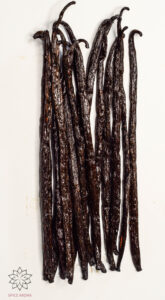Madagascar Vanilla Varieties
Madagascar vanilla is world-renowned for its exceptional quality and captivating aromas. In this article, we will explore the different vanilla varieties grown in Madagascar, highlighting their unique characteristics and culinary uses. Madagascar vanilla is a true aromatic treasure that deserves to be discovered in depth.
Introduction to Madagascar Vanilla
Vanilla, often called “black gold,” is a precious spice that comes from the pods of certain orchids of the genus Vanilla. Madagascar, with its tropical climate and fertile soils, is one of the world’s leading producers of vanilla. Madagascar vanilla is particularly prized for its rich aroma and superior quality. In this article, we will explore the different varieties of vanilla grown in Madagascar and discover what makes them so special.
Bourbon Vanilla from Madagascar
Bourbon vanilla is arguably Madagascar’s most famous variety. It takes its name from the island of Réunion, formerly known as Bourbon Island, where it was first cultivated. Madagascar Bourbon vanilla is renowned for its rich, creamy aroma, with hints of caramel and chocolate. It is widely used in baking, confectionery, and ice cream making. Chefs around the world appreciate Bourbon vanilla for its ability to enhance the flavors of even the most delicate desserts.


Pompona Vanilla from Madagascar
Pompona vanilla, also known as vanillon, is a rare and precious variety. It is characterized by its large, fleshy pods and its intense, spicy aroma. Pompona vanilla is often used in the production of liqueurs and spirits due to its aromatic power. It is also prized for its medicinal properties and health benefits. Madagascar vanilla producers cultivate Pompona vanilla with care to preserve its unique qualities.
Vanilla Cultivation Methods in Madagascar
Growing vanilla is a laborious process that requires a lot of patience and know-how. Vanilla plants are grown in the shade of trees to protect them from the intense sun. Vanilla flowers must be pollinated by hand, a delicate task that requires great precision. Once the pods are harvested, they undergo a drying and fermentation process that can last several months. This process helps develop the complex aromas and rich flavors of Madagascar vanilla.
The Challenges of Vanilla Production in Madagascar
Vanilla production in Madagascar faces many challenges. Fluctuating market prices, unpredictable weather conditions, and vanilla bean thefts are all issues that producers face. Despite these challenges, Madagascar vanilla farmers continue to produce exceptional quality vanilla through their dedication and expertise. Madagascar vanilla remains a luxury product that is valued around the world.
Culinary Uses of Vanilla
Vanilla is a versatile ingredient that can be used in a variety of sweet and savory dishes. In baking, it is often used to flavor cakes, cookies, custards, and ice creams. It can also be added to sauces, marinades, and meat dishes to add a touch of sweetness and complexity. Chefs around the world use Madagascar vanilla to create innovative and delicious dishes.

The Benefits of vanilla of Madagascar
In addition to its culinary uses, Madagascar vanilla also has medicinal properties. It is known for its calming and relaxing effects, and is often used in aromatherapy to reduce stress and anxiety. Vanilla also contains antioxidants that can help protect the body from free radical damage. Additionally, Madagascar vanilla is used in some traditional remedies for its anti-inflammatory and antibacterial properties.
The Economic Impact of Vanilla in Madagascar

Vanilla plays a crucial role in the island’s economy. It represents an important source of income for many farmers and their families. Vanilla farming is labor-intensive, creating jobs in rural areas. In addition, the growing global demand for Madagascar vanilla helps boost the local economy and improve the living conditions of producers.
Preserving the Quality
To ensure the exceptional quality, strict quality control measures are put in place throughout the production process. Vanilla pods are carefully selected and sorted to ensure they meet the highest standards. In addition, traditional drying and fermentation techniques are used to preserve the vanilla’s unique aromas and flavors. These efforts help maintain Madagascar vanilla’s reputation as a premium product.
Conclusion
Vanilla of Madagascar is an aromatic treasure that deserves to be discovered and appreciated. Its different varieties, each with its unique characteristics, offer a wealth of flavors and aromas that make it a precious ingredient in cooking. Despite the challenges of production, Madagascar vanilla producers continue to cultivate this spice with passion and dedication. Whether it is Bourbon vanilla or Pompona vanilla, each variety of vanilla of Madagascar brings a touch of exoticism and refinement to our dishes.
